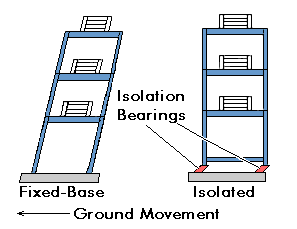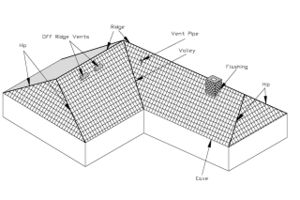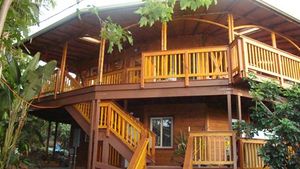When working the tropical areas, several considerations must be taken into account when using earthen building. Much of the tropical areas are prone to both hurricane and earthquake activity. Due to these factors, several design considerations and codes should be used to prevent structures from collapse. While this article will focus mostly on the Dominican Republic, much of the information can be applied to many coastal, tropical climate areas, with an exception for the regulations section.

Regulations[edit | edit source]
Many tropical areas have regulations and requirements for buildings due to being prone to frequent natural disasters. When building in tropical areas, one should check their local regulations before building.
Earthquake Building Design[edit | edit source]
Building in active seismic areas requires different design techniques in order to maintain safety inside a building. Earthquake resistant design follows a couple main principles. Main members of a building should never fall, but may sustain severe but repairable damage due to strong seismic activity. Otherwise, the main members should not sustain damage during seismic activity.[2]

Design Techniques[edit | edit source]
One technique is know as the base isolations. In base isolation, the building can rest on frictionless rollers or flexible pads. This will reduce the amount of force placed on the structure from the earthquake. Generally, these fixed pads are made of rubber and a lead plug, and allow the building to move when forces due to seismic activity act upon it.
A second technique is use energy dissapation devices. While buildings naturally damp the force felt from the earthquake, there is only a limited amount before the buildings structure is compromise. Due to this, damping devices allow greater forces to be dampened and dispersed.
For more in depth see Earthquake proofing for buildings
Hurricanes[edit | edit source]
A hurricane, also known as a typhoon or tropical cyclone, is "a non-frontal synoptic scale low-pressure system over tropical or sub-tropical waters with organized convection (i.e. thunderstorm activity) and definite cyclonic surface wind circulation".[4] In other words, a hurricane is a large storm that begins over tropical or near tropical waters, and contains a circular motion of wind creating an eye and cyclone. Hurricanes need water of at least 80 degrees Fahrenheit, 26.6 degrees Celsius, to form, which is why hurricanes only begin in tropical or near tropical waters. As the hurricane moves toward land, it accumulates water, and strength. Due to this ability to gain strength, hurricanes can be classified in different categories.[5]
Hurricane Building Design[edit | edit source]
Building in hurricane prone areas requires building techniques and materials that will withstand large volumes of water and high winds. Wind loading, the positioning of force on a house or building due to wind, causes major damage to buildings and houses.

Design Techniques[edit | edit source]
The following are techniques for when designing buildings within hurricane prone areas:
- Use building shapes with a floor plan of square, hexagonal or octagonal
- Have a hip roof- a roof with multiple slopes
- Roofs at 30 degrees have the best results
- Connect Roofs with Nails to prevent the roof from being pulled off
- Don't have roof overhangs
If flooding is possible, elevate the structure to prevent flood damage.[7]
Humidity[edit | edit source]
In tropical areas, high humidity is expected, and can change how building materials react due to the increased moisture in the air. Humidity can cause a building material to swell and shrink, and with excessive water, during the rainy seasons or due to hurricanes, earthen building materials can often return to their non-harden form.
Furthermore, the ability to lower or change the humidity inside the building must be taken into consideration. Humans have a comfortability range of 30% to 60% humidity. Lower than 40% over long periods can cause mucous membranes to dry out within the nasal cavities and lungs. On the other hand, humidity higher than 60% is uncomfortable for humans. When building in the tropics, humidity less than 60% is difficult to achieve without the use of a HVAC system.[8] Humidity mostly effects the construction period, in which the earthen building methods are required to dry. Be sure to plan in extra time to allow the materials to completely dry. While all earthen building can work in humid environments, humidity combined with other factors can often limit what should be used.[9]

Earthen Building Techniques[edit | edit source]
Due to the natural disasters which occur in the tropics, certain earthen building techniques are not suitable for this region in the world. For hot, humid climates with a lot of rain fall, materials that will dry easily and not rot are essential. The following discusses different types of earthen building suitable for tropical climates. Constructions materials that preform well in earthquake and hurricane prone areas are as follows:
- Bamboo: It is lighter and allows flexibility during earthquakes, and can withstand high wind speeds[11]
- Wattle and daub with finishes to make rain proof
- Earthbags
Techniques for earthquake and hurricane prone areas:
- Quake Safe: building with wires and sticks to slow collapse
- Superadobe: adobe with the minor addition of concrete
- Tires filled with sand bags to act as damping devices
- Plates floating on ball bearings
Combining Techniques works well in tropical climates that are humid, hurricane and earthquake prone.<ref>http://greenhomebuilding.com/QandA/natural/heat.htm<ref>=== Footnotes and References ===
Earthquake proofing for buildings
Superadobe
- ↑ http://web.archive.org/web/20150827044427/http://www.caribbean-junky.com:80/dominican republic/boca chica.htm
- ↑ Earthquake Resistant Buildings
- ↑ http://web.archive.org/web/20181230202858/http://mceer.buffalo.edu:80/infoservice/reference services/adveqdesign.asp
- ↑ | NOAA Definition of a Hurricane
- ↑ Hurricane categories.
- ↑ http://www.floridadisaster.org/hrg/content/roofs/roof terms.asp
- ↑ http://www.sciencedaily.com/releases/2009/06/090615144213.htm
- ↑ http://web.archive.org/web/20090927084117/http://www.scribd.com:80/doc/19231586/Architecture-eBook-Building-With-Earth-Design-and-Technology-of-a-Sustainable-Architecture-Gernot-Minke-Birkhauser-2006dg2005
- ↑ http://greenhomebuilding.com/QandA/natural/heat.htm
- ↑ http://greenplanetparadise.com/wp-content/media/post/bamboo-house-hawaii.jpg
- ↑ http://greenplanetparadise.com/2213/bamboo-houses-why-bamboo